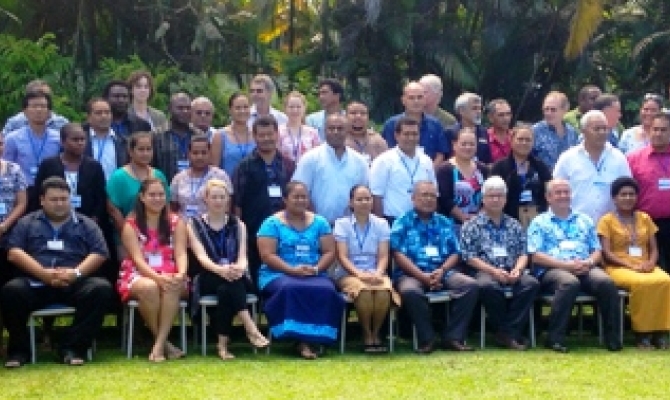
Island and Ocean Ecosystems
By Steve Pogonowski, 10 December 2013, Suva Fiji - The complex and little-understood nature of deep sea biological communities needs to be further researched before any deep sea mining licenses are granted in the Central and West Pacific.
Speakers at the 4th Regional Training Workshop: Environmental Perspectives of Deep Sea Mineral Activities in Nadi, Fiji, discussed the potential commercial value of deep sea minerals and the expensive but vital research that should be continued to determine the impacts of mining on abyssal plain, seamount and hydrothermal vent communities.

The four-day workshop, organised by the Secretariat of the Pacific Regional Environment Programme (SPREP) and the Secretariat of the Pacific Community (SPC), aims to build on the work undertaken by the SPC-EU Deep Sea Minerals Project to strengthen governance systems in Pacific island countries and territories to manage and minimise environmental impacts from mining activities.
Mining companies have yet to start any mining operation in the deep sea but are exploring several zones in the Central and West Pacific, searching for rich deposits of manganese nodules, cobalt-rich crusts andseafloor massive sulphides.
Duke University Marine Laboratory director Professor Cindy Van Dover, who has piloted the Alvin submersible to assess deep sea environments, said mining operations could have potentially long-term impacts on the fish, molluscs, sponge and worm communities of the deep sea.
"A single mining event could have the same impact as a volcanic eruption and it would be no big deal. Multiple events would be different," she said.
"Hydrothermal vents are likely to be more resilient than anything else ... but there's still potential for things to go wrong."
Prof Dover said hydrothermal vents, a key target for seafloor massive sulphide mining, were also being utilised for their genetic resources to develop medical, pharmaceutical, cosmetic and therapeutic products.
Dr Malcolm Clark, Principal Scientist at New Zealand's National Institute of Water and Atmospheric Research (NIWA), said the faunal communities in manganese nodule and cobalt-rich crust environments were very different and mining operations should build in large buffer zones to reduce impacts.
Professor Mike Petterson, director of SPC's Applied Geoscience and Technology Division (SOPAC), also launched theSPC-UNEP/GRID-Arendal Pacific Marine Minerals Assessment Report and presented Mr Samuela Namosimalua, Permanent Secretary, Fijian Ministry of Local Government and Environment, with copies of the report.
More information on the SPC-EU Deep Sea Minerals Project
Speakers at the 4th Regional Training Workshop: Environmental Perspectives of Deep Sea Mineral Activities in Nadi, Fiji, discussed the potential commercial value of deep sea minerals and the expensive but vital research that should be continued to determine the impacts of mining on abyssal plain, seamount and hydrothermal vent communities.

The four-day workshop, organised by the Secretariat of the Pacific Regional Environment Programme (SPREP) and the Secretariat of the Pacific Community (SPC), aims to build on the work undertaken by the SPC-EU Deep Sea Minerals Project to strengthen governance systems in Pacific island countries and territories to manage and minimise environmental impacts from mining activities.
Mining companies have yet to start any mining operation in the deep sea but are exploring several zones in the Central and West Pacific, searching for rich deposits of manganese nodules, cobalt-rich crusts andseafloor massive sulphides.
Duke University Marine Laboratory director Professor Cindy Van Dover, who has piloted the Alvin submersible to assess deep sea environments, said mining operations could have potentially long-term impacts on the fish, molluscs, sponge and worm communities of the deep sea.
"A single mining event could have the same impact as a volcanic eruption and it would be no big deal. Multiple events would be different," she said.
"Hydrothermal vents are likely to be more resilient than anything else ... but there's still potential for things to go wrong."
Prof Dover said hydrothermal vents, a key target for seafloor massive sulphide mining, were also being utilised for their genetic resources to develop medical, pharmaceutical, cosmetic and therapeutic products.
Dr Malcolm Clark, Principal Scientist at New Zealand's National Institute of Water and Atmospheric Research (NIWA), said the faunal communities in manganese nodule and cobalt-rich crust environments were very different and mining operations should build in large buffer zones to reduce impacts.
Professor Mike Petterson, director of SPC's Applied Geoscience and Technology Division (SOPAC), also launched theSPC-UNEP/GRID-Arendal Pacific Marine Minerals Assessment Report and presented Mr Samuela Namosimalua, Permanent Secretary, Fijian Ministry of Local Government and Environment, with copies of the report.
More information on the SPC-EU Deep Sea Minerals Project